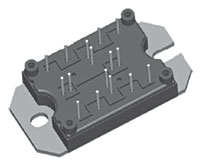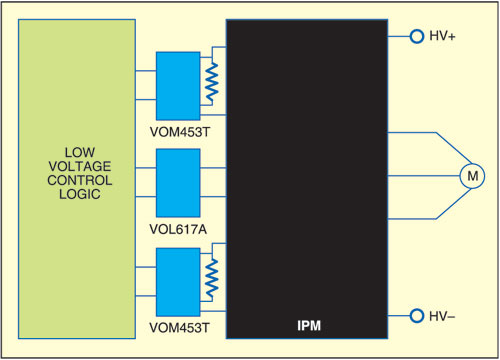For many years, insulated-gate bipolar transistors (IGBTs) have combined the advantages of bipolar transistors with the ease of control of MOSFETs. Therefore in spite of the rapid development of possible replacements, IGBTs are likely to be with us for years to come.

Currently, no other practical and readily available device can handle switching applications at the power levels available with IGBTs. Despite the high power levels that characterise these applications, the motivation to integrate components has not decreased. Designers currently have several levels of integration available to them. One approach is to simply integrate multiple IGBTs into one standard package, such as the 6PAK module shown in Fig. 1.
The next step in high-power IGBT integration is the intelligent power module (IPM), which includes IGBTs, IGBT drivers, fault detection and fault tolerance control circuitry. In IPM modules these are all combined in one package. The IPM integrates all parts of a power stage aside from the timing signals, which are usually provided by a low-voltage level microcontroller, FPGA, CPLD or custom ASIC, as shown in Fig. 2.
Microcontrollers and FPGAs are very sensitive to the electrical noise generated by high-power switching devices such as IGBTs and IPMs. Electrically isolating noisy IPM-based power trains from sensitive control circuitry for safety and performance is the ideal application for a class of high-speed optocouplers commonly referred to as IPM drivers.

Though it is possible from a functional point of view to obtain acceptable performance without isolating the logic control circuitry from the high-voltage/high-power output stages of industrial AC drives, solar inverters and other high-output power switching devices, it is not advisable for a number of reasons. First of all, most domestic and international electrical safety agency regulations preclude the possibility of doing away with isolation between a potentially lethal high-voltage circuit and user-accessible low-voltage control circuitry. Secondly, while it may be possible to implement a non-isolated solution through a sufficiently large amount of effort and expensive testing, it will complicate the design unnecessarily. The output stage of a high-power switch-mode system is full of high-frequency harmonics, unwanted ground potential differences, ground currents and near-field radiated emissions. These are all unwanted byproducts of high-frequency, high-power switching that can adversely affect the operation of low-voltage control circuitry.
So, can an experienced engineer achieve a working design without isolation? Yes, but the complexity, design cycle time and design risk will all be raised unnecessarily. A judicial sprinkling of IPM drivers can greatly simplify the design while meeting the requirements of safety agencies.







